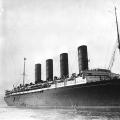Sculptures of Salvador Dali: photos and descriptions of sculptures. Telephone-lobster - sculpture by Salvador Dali with a handset Sculpture of Dali telephone handset
The most famous surrealist designer is Elsa Schiaparelli. She constantly collaborated with photographers and artists (by the way, not only with surrealists, but also with Dadaists). It was Schiaparelli who made surrealism fashionable. Her most famous works are invariably associated with the name of Salvador Dali. The artist created prints for the legendary dress with drawn cuts and tears, and also suggested placing an image of a huge lobster on a snow-white dress. Lobsters often became art objects in his hands. Dali invented a telephone with a receiver in the shape of a giant lobster, and during the creation of the surreal pavilion “The Dream of Venus” he decorated the naked bodies of models with seafood.
If you also want to try on a lobster, then mono earrings, beaded brooches, rings and large pendants are at your disposal.
Anatomy
Schiaparelli also collaborated with Jean Cocteau. Together with this artist, she came up with the famous coat with the profiles of people practically touching their noses and their profiles forming the silhouette of a flower vase. In surrealism, the human body is an object for experimentation. It falls apart, becomes distorted, and sometimes frightens. In this sense, jewelry is an excellent basis for such experiments: hands embroidered with sequins and stones, heart-shaped cufflinks and similar things are made by many brands today.
Lips and eyes
Surrealists often turned women's lips, painted with bright lipstick, into objects of art and design: think of a bottle of perfume or a sofa by Salvador Dali. In the fashion world, lips also often adorned clothing (for example, the famous dress from Saint Laurent's 1971 collection, with lips made of scarlet and crimson sequins). In the situation with jewelry, familiar materials became something unexpected, something more than just beautiful trinkets in the form of stars or flowers. Brooches with pearl teeth, sapphire tears and hearts made of rubies have become real art objects.
From May 25, an exhibition of bronze sculptures by the most famous surrealist Salvador Dali opens in Erarta. The gallery brought the collection of Benjamino Levi, Dali's friend and patron. It was he who suggested that the artist cast fantasy images from his paintings in bronze. We tell you what to see in the exhibition and how to understand the artist’s work.
"Adam and Eve"
One of the earliest (among those presented) works. The original gouache on paper was made in 1968, and the sculpture was cast in 1984. Dali depicts the most dramatic moment in Eden: Eve invites Adam to taste the forbidden fruit. He, not yet knowing how his fall from grace will turn out for humanity, raises his hand in amazement and indecision. Knowing of the impending expulsion from paradise, the snake tries to comfort the doomed (and soon mortal) people and curls into the shape of a heart, reminding Adam and Eve that they still have love. And it is something whole, which is always greater than the sum of its individual parts.

"The Nobility of Time"
One of the most widely replicated images invented by Dali: a clock thrown over the branch of a dead tree. For a surrealist, time is not linear - it merges with space. The softness of the clock also hints at the psychological perception of time: when we are bored or uncomfortable, it moves slower. The weak-willed clock no longer shows time, no longer measures its passage. This means that the speed of our time depends only on us.
The clock falls on a dead tree, the branches of which have already given birth to new life, and the roots have covered the stone. The tree trunk also serves as a support for the clock. The term "watch crown" in English also refers to the mechanical device that allows you to set the hands and wind the watch. But according to Dali's clock it is unchanged - it cannot be established. Without movement, the “crown” becomes royal, which adorns the clock and indicates that time does not serve people, but rules over them. He is accompanied by two recurring fantastic symbols: a contemplating angel and a woman wrapped in a shawl. Time reigns over both art and reality.

"Alice in Wonderland"
Like Carroll's heroine, Dali, armed with a creative imagination, traveled along a difficult and long road in the land of dreams. The artist was attracted by the incredible plot and extravagant characters of the fairy tale. Alice is an eternal child, capable of comprehending the absurd logic of both Wonderland and Beyond. In the sculpture, her jump rope has been transformed into a braided cord, symbolizing everyday life. Roses bloomed on her hands and in her hair, symbolizing feminine beauty and eternal youth. And the peplum dress is reminiscent of ancient examples of perfection of form.

"Tribute to fashion"
Dali's relationship with high fashion began in the 1930s through his work with Coco Chanel, Elsa Schiaparelli and Vogue magazine and continued throughout his life. The head of Venus, frozen in a supermodel pose, is decorated with roses - a symbol of innocence. Her face is featureless, allowing the admirer to imagine the face he wishes. He is a “dandy” and is on one knee in front of her.

"Adoration of Terpsichore"
The muse of dance in Dali’s interpretation creates two mirror images: a soft figure is contrasted with a hard and frozen one. The absence of facial features emphasizes the symbolic sound of the composition. The dancer, with her flowing classical forms, represents Grace and the unconscious, while the angular, cubist second figure speaks of the ever-growing and chaotic rhythm of life.

"Snail and Angel"
The sculpture refers to the artist’s meeting with Sigmund Freud, whom he considered his spiritual father. Psychoanalytic ideas that influenced Dali in the early stages of the development of surrealism were reflected in many works. A snail perched on the seat of a bicycle that stood not far from Freud’s house captured Dali’s imagination. He saw in it a human head - the very founder of psychoanalysis.
Dali was obsessed with the image of the snail because it contains a paradoxical combination of softness (the animal's body) with hardness (its shell). Therefore, the generally accepted symbol of idle pastime receives wings from him and easily moves along the waves. And the messenger of the gods, capable of developing limitless speed, sat down for a short moment on the back of the snail, endowing it with the gift of movement.

"Vision of an Angel"
Salvador Dali interprets the classic religious image. The thumb from which life arises (tree branches) symbolizes the power and dominance of the Absolute. On the right side of the deity is humanity: a man in the prime of his life. On the left side is an angel symbolizing the spirit of contemplation; his wings rest on a crutch. Although man is united with God, divine knowledge is superior to his own.
Undoubtedly, the name of Salvador Dali is known throughout the world. And this is primarily due to his own merit: Dali was an artist, sculptor, writer, and director. He had his own unique view of the world and was a prominent representative of surrealism.
Surrealism is a movement in art, its homeland is France, the distinctive feature of which is a combination of paradoxical forms and illusions. It also has this concept: combining dream and reality. This direction has many followers, including Salvador Dali.
His work was greatly influenced by his muse and also his wife, Gala. It was she who was often depicted by the artist in his canvases. Many also remember the sculptures of the great Spaniard.
Among them is a telephone receiver with a lobster located on it. The lobster itself is made of plaster, and the phone is real. In this sculpture Dali wanted to show a protest to the whole world against the development of technology. He believed that technological communications alienate people from each other.

The exhibition itself was first presented in 1936 at the London Exhibition of Surrealist Art. In total, the sculpture was made in five versions and can now be viewed in various museums around the world: in Australia, in Liverpool, and so on.
One of the most prominent representatives of surrealism - Salvador Dali was not only an outstanding painter and graphic artist, but also a sculptor, creating his creations exclusively from wax. His surrealism was always cramped within the framework of the canvas, and he resorted to three-dimensional depiction of complex images, which later formed the basis of his paintings.
Collector Isidr Klot, who once bought his wax figures from the artist, ordered bronze castings. Soon the collection of original bronze sculptures created a sensation in the world of art. Many of Dali’s sculptures were subsequently increased many times in size and became decorations not only in museum halls, but also in the squares of many cities around the world.
Salvador Dali Museum in Paris
In Paris, Montmartre, there is an entire museum dedicated to this brilliant Spanish artist. The greatest works of art created in the last century arouse genuine interest among the public and cannot leave any viewer indifferent: they awaken either delight or indignation.
Dance of Time I.
https://static.kulturologia.ru/files/u21941/219414890.jpg" alt=" Surreal piano by Salvador Dali. | Photo: dolzhenkov.ru." title="Surreal piano by Salvador Dali. | Photo: dolzhenkov.ru." border="0" vspace="5">!}
Exquisite objects and forms inspired the artist to create many unique surreal images. In this sculpture, the master replaced the wooden legs of a piano with dancing, graceful female legs. In this way, he revived the instrument and turned it into an object of pleasure for both music and dance. On the lid of the piano we see a surreal image of the Muse trying to soar above reality.
Space elephant.

Salvador Dali turned to the image of an elephant both in painting, as evidenced by the painting “The Temptation of St. Anthony”, and repeatedly in sculpture - “Cosmic Elephant”, “Rejoicing Elephant”. This bronze sculpture depicts an elephant walking on thin long legs through outer space, carrying an obelisk symbolizing technological progress. A powerful body on thin legs, according to the author’s idea, is nothing more than “the contrast between the inviolability of the Past and the fragility of the Present.”
Surreal Newton

In his work, the great Spaniard repeatedly turned to the personality of Newton, who discovered the law of universal gravitation, thereby paying tribute to the great physicist. In all the sculptures of Newton created by Dali, the apple is a constant detail, which led to the great discovery. Two large through niches in the sculpture symbolize oblivion, since in the perception of many people Newton is only a great name that is devoid of soul and heart.
Bird Man
a person is half-bird, or a bird is half-man." It is difficult to determine which part of these two dominates, because a person is not always who he appears to be. The author wants to leave us in doubt - this is his game.
Vision of an angel
https://static.kulturologia.ru/files/u21941/000dali-0015.jpg" alt=" Woman on Fire. Author: Salvador Dali. Photo: dolzhenkov.ru." title="Woman on fire.
The obsession of two ideas: the flame of passion and the female body with secret drawers in which the secrets of every woman are kept, Salvador Dali clearly manifested himself in surreal sculpture"Женщина в огне". Под пламенем художник подразумевал подсознательное страстное желание и пороки всех женщин - нынешних, прошлых и будущих, а выдвижные ящички символизируют сознательную секретную жизнь каждой из них.!}
Snail and angel
Surreal warrior.
Surreal warrior.
Dali's surreal warrior symbolizes all victories: real and metaphysical, spiritual and physical.
Tribute to Terpsichore
https://static.kulturologia.ru/files/u21941/000dali-0009.jpg" alt=" Cosmic Venus. Author: Salvador Dali. | Photo: dolzhenkov.ru." title="Cosmic Venus.
This sculpture is also called “beauty without head and limbs.” In this work, the artist glorifies a woman whose beauty is temporary, fleeting and perishable. Venus's body is divided into two parts by an egg, which creates a fantastic impression of weightlessness in the sculpture. The egg itself is a symbol of the fact that inside a woman there is a whole unknown world.
Horse under the saddle of time
The image is filled with expression, eternal non-stop movement, original freedom and insubordination to man.".!}
Space Rhino
https://static.kulturologia.ru/files/u21941/000dali-0013.jpg" alt=" Saint George and the Dragon. Author: Salvador Dali. | Photo: dolzhenkov.ru." title="Saint George and the Dragon.
https://static.kulturologia.ru/files/u21941/219416024.jpg" alt="Surrealism of Salvador Dali. | Photo: dolzhenkov.ru." title="Surrealism of Salvador Dali. | Photo: dolzhenkov.ru." border="0" vspace="5">!}
Spain. Night Marbella. Sculptures of Salvador Dali
Ten bronze sculptures, based on wax models of Salvador Dali sculptures, are located right in the open air on the Marbella promenade in Spain.

 How to travel to Italy on your own?
How to travel to Italy on your own? Submarines of Japan 1941 1945
Submarines of Japan 1941 1945 About the deportation of Karachais
About the deportation of Karachais